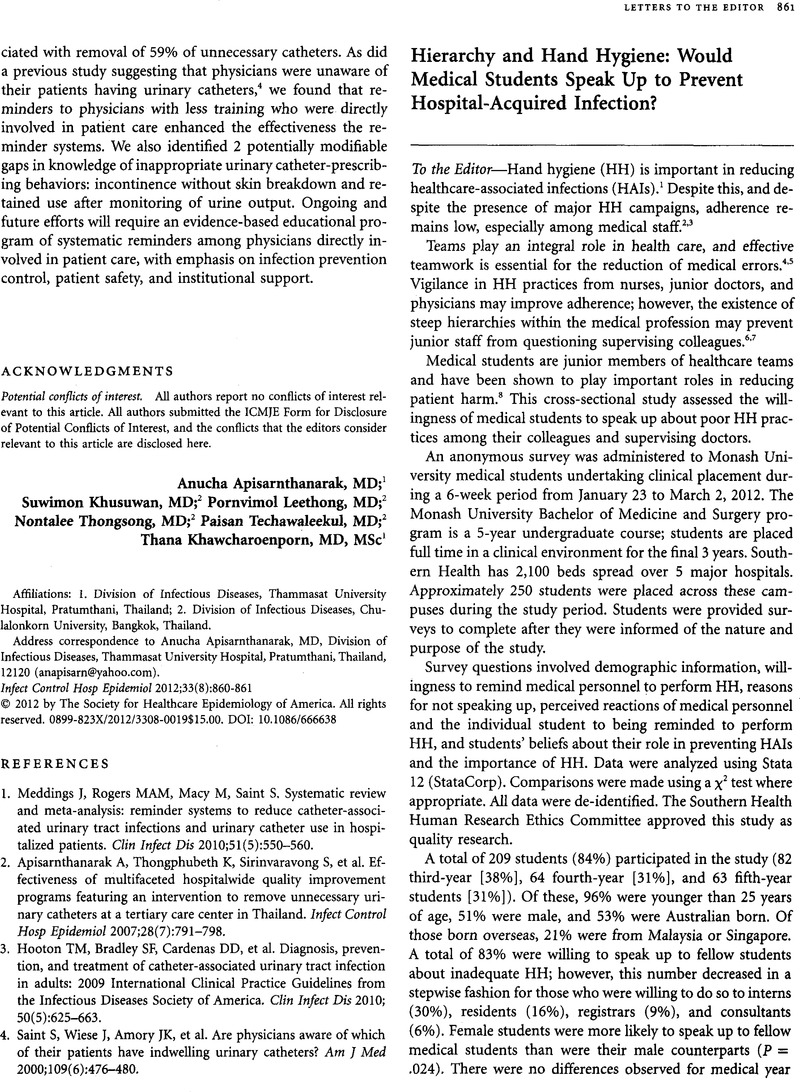Crossref Citations
This article has been cited by the following publications. This list is generated based on data provided by Crossref.
McGuckin, M.
and
Govednik, J.
2013.
Patient empowerment and hand hygiene, 1997–2012.
Journal of Hospital Infection,
Vol. 84,
Issue. 3,
p.
191.
Herbert, Verena G.
Schlumm, Paul
Kessler, Harald H.
and
Frings, Andreas
2013.
Knowledge of and Adherence to Hygiene Guidelines among Medical Students in Austria.
Interdisciplinary Perspectives on Infectious Diseases,
Vol. 2013,
Issue. ,
p.
1.
Kaur, R.
Razee, H.
and
Seale, H.
2014.
Facilitators and barriers around teaching concepts of hand hygiene to undergraduate medical students.
Journal of Hospital Infection,
Vol. 88,
Issue. 1,
p.
28.
Pan, Sung-Ching
Lai, Tai-Shuan
Tien, Kuei-Lien
Hung, I-Chen
Chie, Wei-Chu
Chen, Yee-Chun
and
Chang, Shan-Chwen
2014.
Medical students' perceptions of their role as covert observers of hand hygiene.
American Journal of Infection Control,
Vol. 42,
Issue. 3,
p.
231.
Schwappach, D L B
and
Gehring, K
2014.
‘Saying it without words’: a qualitative study of oncology staff's experiences with speaking up about safety concerns.
BMJ Open,
Vol. 4,
Issue. 5,
p.
e004740.
Schwappach, D.L.B.
and
Gehring, K.
2015.
Frequency of and predictors for withholding patient safety concerns among oncology staff: a survey study.
European Journal of Cancer Care,
Vol. 24,
Issue. 3,
p.
395.
Szymczak, Julia E.
2016.
The Sociology of Healthcare Safety and Quality.
p.
140.
Szymczak, Julia E.
2016.
Infections and interaction rituals in the organisation: clinician accounts of speaking up or remaining silent in the face of threats to patient safety.
Sociology of Health & Illness,
Vol. 38,
Issue. 2,
p.
325.
Jammali-Blasi, Asmara
McInnes, Elizabeth
and
Middleton, Sandy
2016.
A survey of acute care clinicians' views on factors influencing hand hygiene practice and actions to improve hand hygiene compliance.
Infection, Disease & Health,
Vol. 21,
Issue. 1,
p.
16.
Tai, Joanna Hong Meng
Canny, Benedict J.
Haines, Terry P.
and
Molloy, Elizabeth K.
2017.
Implementing Peer Learning in Clinical Education: A Framework to Address Challenges In the “Real World”.
Teaching and Learning in Medicine,
Vol. 29,
Issue. 2,
p.
162.
Boyce, John M.
Allegranzi, Benedetta
and
Pittet, Didier
2017.
Hand Hygiene.
p.
85.
Kaur, R.
Razee, H.
and
Seale, H.
2017.
Setting the right foundations: improving the approach used to teach concepts of hand hygiene to medical students.
Journal of Hospital Infection,
Vol. 95,
Issue. 4,
p.
355.
Schwappach, David
Sendlhofer, Gerald
Häsler, Lynn
Gombotz, Veronika
Leitgeb, Karina
Hoffmann, Magdalena
Jantscher, Lydia
and
Brunner, Gernot
2018.
Speaking up behaviors and safety climate in an Austrian university hospital.
International Journal for Quality in Health Care,
Vol. 30,
Issue. 9,
p.
701.
Schwappach, David L.B.
2018.
Speaking up about hand hygiene failures: A vignette survey study among healthcare professionals.
American Journal of Infection Control,
Vol. 46,
Issue. 8,
p.
870.
Schwappach, David
Sendlhofer, Gerald
Kamolz, Lars-Peter
Köle, Wolfgang
Brunner, Gernot
and
Schultz, Tim
2019.
Speaking up culture of medical students within an academic teaching hospital: Need of faculty working in patient safety.
PLOS ONE,
Vol. 14,
Issue. 9,
p.
e0222461.
Schwappach, David
and
Sendlhofer, Gerald
2020.
Speaking Up about Patient Safety in Perioperative Care: Differences between Academic and Nonacademic Hospitals in Austria and Switzerland.
Journal of Investigative Surgery,
Vol. 33,
Issue. 8,
p.
730.
Hubbard, Ella
Poole, Grace Olivia Jane
and
Melamed, Naomi
2020.
Response to: Medical student strategies for actively negotiating hierarchy in the clinical environment.
Medical Education,
Vol. 54,
Issue. 4,
p.
375.
Matthews, Rachel
Smith-Han, Kelby
and
Nicholson, Helen
2020.
From physiotherapy to the army: negotiating previously developed professional identities in mature medical students.
Advances in Health Sciences Education,
Vol. 25,
Issue. 3,
p.
607.
Mohd Ali, Noor Azizah
Jauncey, Jacqueline
Ballard, Emma L
and
Bogossian, Fiona
2021.
Educating parents on ‘Speaking up for hand hygiene’ in PICU: Perceptions and barriers.
INTERNATIONAL JOURNAL OF CARE SCHOLARS,
Vol. 4,
Issue. Supp1,
p.
70.
Ortiz‐López, Nicolás
Ponce‐Arancibia, Sofía
Olea‐Gangas, Carolina
Chacano‐Muñoz, Rodrigo
Arancibia‐Carvajal, Sara
and
Solis, Ivan
2022.
Determinants of the intention to speak up about medical error in primary healthcare settings in Chile.
Health & Social Care in the Community,
Vol. 30,
Issue. 4,





